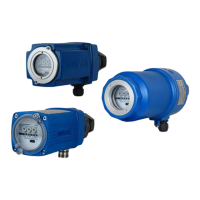6 | Configuration and function
42
D-LX 201/721
IR/UV
Analogue 1
Analogue 2
Channel 1
Channel 2
Ready for
operation
Flame
on/off
Modbus
0/4 ... 20 mA
Optical
output
Fig.6.3: Functional diagram
In order to control and monitor the safety-relevant flame monitoring functions and the
self-monitoring, the dynamic signals from the flame are evaluated in both microcontrol-
lers for output of the flame ON or flame OFF notifications, depending on the specified
switching threshold [}115] (frequency, intensity).
Two relay contacts connected in series are available for the flame notification, as well
as a green LED on the back of the device. The intensity of the flame notification can
also be displayed via a fieldbus, an optical data bus and a 0/4 … 20 mA analogue out-
put.
Operational readiness, or the presence of a fault, is signalled via a contact of the dy-
namically controlled relay for the operational readiness notification, with monitoring of
the internal operating voltages and all safety-relevant hardware functions, and via
LEDs on the back of the device.
A single-channel microcontroller (MC3) controls the non-safety-relevant input and out-
put functions.
The internal power supply unit converts 24 V to 12/3.3 V (with potential separation).
6.1.1 Infra-red flame sensor
A flame's IR radiation zone is often extensive, and is very intensive when compared to
UV radiation. The IR zone is therefore easy to detect from various different viewing
angles, has a strong signalling effect and is resistant to absorption by gases. The IR
flame sensor, however, is more sensitive to background radiation when compared to a
UV flame sensor.
If a flame appears yellow or red, then it is "visible" for this type of flame monitor. How-
ever, this requires movement (dynamic) within the flame.
In D−LX xxx IG, an InGaAs photodiode with a spectral sensitivity of λ = 780 nm to
1800 nm is used. The integrated flame sensor can therefore detect the dynamic radi-
ation range generated by almost all fuels. This flame monitor has a strong signalling
effect but lower selectivity due to the extensive IR emission zones.
Flames that involve the absorption of short-wave UV radiation by dust, water vapour
or other substances can be monitored in the IR range. Application examples include
waste incineration plants and wood combustions.

